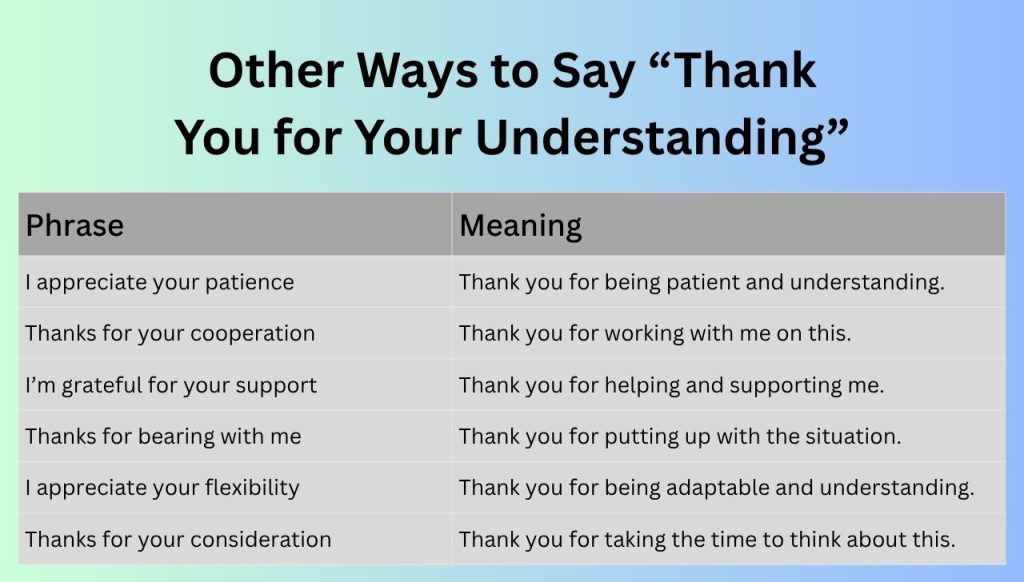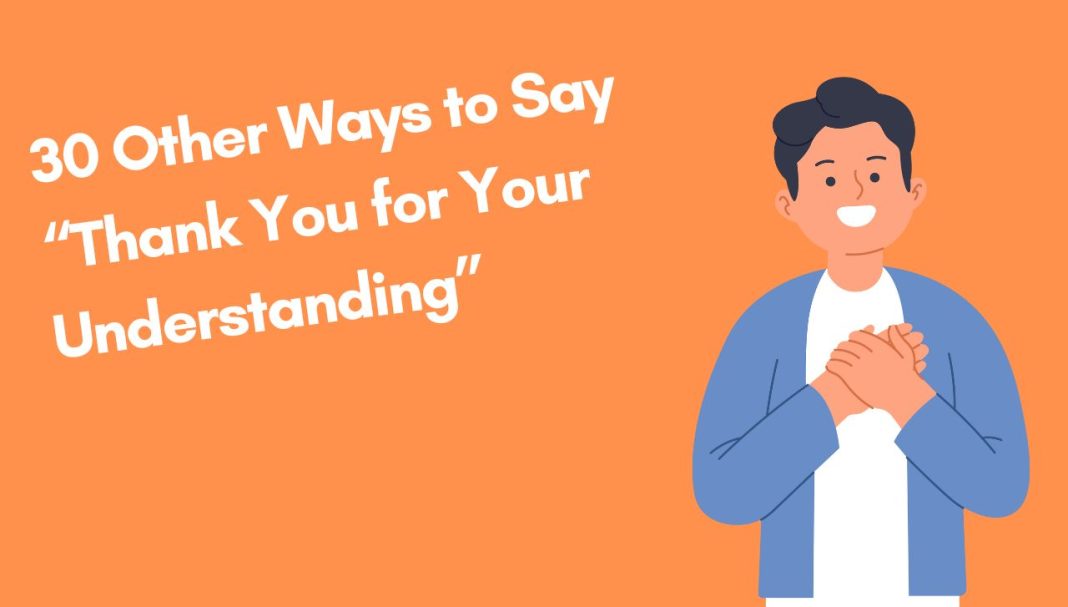Saying “Thank you for your understanding” can feel worn out. Luckily, many ways exist to say the same thing without repeating yourself. Whether you’re writing to a colleague, a friend, or a client, switching up your phrases keeps things fresh. Let’s explore 30 ways to express gratitude and show appreciation without sounding too formal or repetitive.
What “Thank You for Your Understanding” Means
This phrase shows appreciation for someone’s patience. It’s used when things don’t go as planned and someone accepts the situation without frustration. For example, if a meeting is delayed or a product is out of stock, you say it to thank them for being tolerant.
It’s about recognizing that the person is patient and understanding, even if things aren’t ideal.
Dive Deeper: 30 Creative Alternatives to ‘Looking Forward to Seeing You’
When to Use “Thank You for Your Understanding”
Thank you for your understanding” is a simple yet powerful phrase. It shows gratitude for someone’s patience or tolerance in a situation. Often used in emails or conversations, it acknowledges inconvenience or delay. It’s polite and respectful, yet not overused. Knowing when to say it can strengthen relationships, making it clear that you value the other person’s perspective. It’s a subtle way of saying, “I appreciate you.”
Here’s when you might say it:
- Delays or schedule changes
- If you can’t meet a deadline or have to change plans, thank them for their flexibility.
- Service or product issues
- If something is unavailable or delayed, express gratitude for their patience.
- Rescheduling appointments
- When you must cancel or move a meeting, thank them for adjusting.
- Unexpected problems
- Life happens. Showing thanks for understanding can ease tension.
- Mistakes or misunderstandings
- A quick thank you shows you value their patience if something goes wrong.
Why You Should Say “Thank You for Your Understanding”
Saying thank you matters. Here’s why:
- It shows appreciation
- Acknowledge someone’s patience so they know you don’t take it for granted.
- It keeps relationships strong
- Gratitude helps avoid friction when things don’t go smoothly.
- It builds respect
- Saying thank you strengthens mutual respect.
- It prevents conflict
- When things go wrong, gratitude can calm nerves and to avoid frustration.

Other Ways to Say “Thank You for Your Understanding”
| Phrase | Meaning |
|---|---|
| I appreciate your patience | Thank you for being patient and understanding. |
| Thanks for your cooperation | Thank you for working with me on this. |
| I’m grateful for your support | Thank you for helping and supporting me. |
| Thanks for bearing with me | Thank you for putting up with the situation. |
| I appreciate your flexibility | Thank you for being adaptable and understanding. |
| Thanks for your consideration | Thank you for taking the time to think about this. |
| I’m thankful for your help | Thank you for offering your assistance. |
| Thanks for your tolerance | Thank you for being tolerant and understanding. |
| I appreciate your kindness | Thank you for your kindness and consideration. |
| Thank you for your empathy | Thank you for understanding my feelings. |
| I’m grateful for your patience and understanding | Thank you for being both patient and understanding. |
| Thanks for your understanding and patience | Thank you for being both understanding and patient. |
| Thanks for your time and attention | Thank you for focusing on the matter. |
| I’m thankful for your willingness to help | Thank you for being willing to assist. |
| Thanks for your prompt response | Thank you for responding quickly and understanding. |
| Thanks for being so understanding | Thank you for your deep understanding. |
| I’m grateful for your patience in this matter | Thank you for being patient with the issue. |
| Thank you for your thoughtful response | Thank you for considering and responding thoughtfully. |
| Thanks for helping me out | Thank you for offering your assistance. |
| I’m appreciative of your understanding | I appreciate the way you understand the situation. |
| Thanks for your collaboration | Thank you for working together on this matter. |
| Thank you for your helpfulness | Thank you for being helpful. |
| I’m grateful for your calmness | Thank you for remaining calm and understanding. |
| Thank you for your open-mindedness | Thank you for being open to different perspectives. |
| Thanks for your understanding during this time | Thank you for your patience and understanding. |
| I appreciate your quick action | Thank you for your fast response and understanding. |
| Thanks for being so accommodating | Thank you for adjusting and accommodating my needs. |
| I’m thankful for your thoroughness | Thank you for taking the time to thoroughly understand. |
| Thanks for being patient with the situation | Thank you for bearing with the issue. |
| I appreciate your calm approach | Thank you for handling the situation with calmness. |
| Thank you for being so considerate | Thank you for being thoughtful and considerate. |
| Thanks for your readiness to help | Thank you for being ready to offer assistance. |
| I appreciate your attentiveness | Thank you for paying attention and understanding. |
| Thank you for your good-natured response | Thank you for your kind and understanding response. |
Dive Deeper: 30 Ways to Say “Please Note” Differently
Conclusion:
Changing how you say “thank you” can make your message feel more genuine. These alternatives not only avoid repetition but also add a personal touch. Next time, try one—it could make all the difference.

Grammar Nerd, ESL Trainer, Low-Key Comma Crusader
Daniel has taught English for over a decade, from small community classes in Oaxaca to bustling university halls in London. He has a knack for turning even the driest grammar points into relatable, real-life language tools—think fewer red pens, more real talk. He co-founded Grammation to make grammar less gatekeeper-y and more global. When he’s not decoding sentence structures, he’s probably hiking with a paperback novel or adding unnecessary hyphens for fun.
“The rules of grammar should empower people—not trip them up.”


